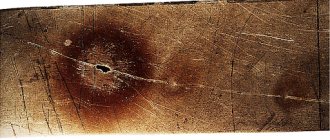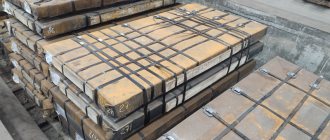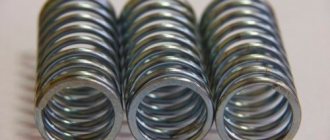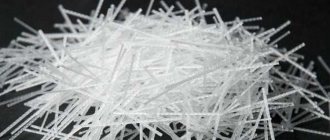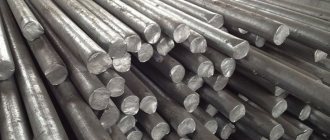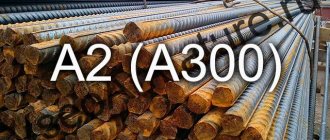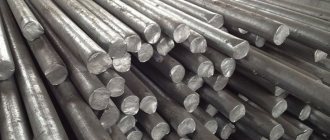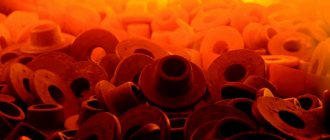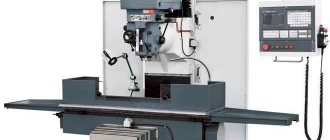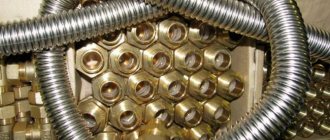Steel 30KhGSA is one of the most popular in industry and in some ways even a legendary alloy, which has gone down in history as a breakthrough at the time of its discovery. The brand was discovered before the start of the war by Soviet scientists I.I. Sidorin and G.V. Akimov by employees of VIAM (All-Union Institute of Aviation Materials). For several years, 30KhGSA steel became the world leader among materials for aircraft construction and was successfully used by Soviet aviation during the war. Until now, Steel 30KhGSA is used in aircraft construction, mechanical engineering, shipbuilding and many other sectors of both civilian and military industry.
30ХГСА - decoding of steel grade
Steel 30KhGSA belongs to the group of alloy steels. Its composition is regulated by GOST 4543-71, according to which each letter and number indicates a certain content of certain chemical elements:
- The number 30 means carbon content of 0.28-0.34%. Carbon increases hardness and strength in steels, but reduces ductility and weldability.
- X – chromium (0.8-1.1%) increases the hardenability, corrosion resistance and heat resistance of the alloy. Has a positive effect on abrasive wear resistance.
- G – manganese (0.8-1.1%) removes harmful impurities of oxygen and sulfur. Reduces the risk of scale and cracking during heat treatment. Improves surface quality. In addition, it helps to increase the steel’s ductility and weldability.
- C – silicon, like manganese, is a strong deoxidizing agent. Increases ductility without reducing strength. Increases the susceptibility of steel to heat treatment.
- The letter "A" stands for improved. This means that the steel has been hardened and tempered. Features of hardening include heating the steel to a temperature of 870 ºС and subsequent rapid cooling in oil or water. Thus, a transformation of the internal structure occurs, which helps to increase the mechanical characteristics of 30KhGSA by 2.9 times. Quenching stresses are removed by high tempering: heating to 540-560 ºС. In addition to stress relief, a parallel increase in elastic properties occurs.
- Sulfur (up to 0.25%) and phosphorus (up to 0.25%) are classified as harmful impurities. The sizes of their molecules are too large compared to all of the above elements. Being built into the crystalline network of steel, sulfur and phosphorus reduce its stability, thereby reducing the strength of the alloy.
- 30KhGSA also contains a certain percentage of copper and nickel. But their content is so small that they do not affect the characteristics of steel.
30KhGSA is the Russian designation for the steel grade.
Analogs
There are the following foreign analogues:
- Poland 30HGSA.
- Bulgaria 30ChGSA.
- Czech Republic 14331.
Product range
- Pipes.
- Forged blanks and forgings.
- Strip iron.
- Sheets are thick and thin.
- Rolled products – long products, shaped products.
- The rods are calibrated and ground.
Designation
The first position is a number. Characterizes the percentage of carbon (in hundredths, therefore 0.3%). In accordance with the accepted classification, this steel is classified as medium alloy.
The second is letters. Correspond to the names of alloying additives. The absence of numbers after this group indicates that their content in steel is no more than 1%.
The third position is the letter (in this case “A”). Means that this brand is considered high quality.
What does the steel marking mean?
It has become quite easy to decipher the brand; you just need to have certain information. Structural steels of ordinary quality and not containing alloying elements are marked with the letter combination “St”. By the number following the letters in the name of the brand, you can determine how much carbon is in such an alloy (calculated in tenths of a percent). The numbers may be followed by the letters “KP”: from them it becomes clear that this alloy has not completely gone through the deoxidation process in the furnace, and accordingly, it belongs to the boiling category. If the brand name does not contain such letters, then the steel corresponds to the calm category.
Chemical composition of carbon structural steels of ordinary quality
Structural unalloyed steel, which belongs to the quality category, has two numbers in its designation; they are used to determine the average carbon content in it (calculated in hundredths of a percent).
Before we begin to consider the grades of those steels that include alloying additives, you should understand how these additives are designated. Marking of alloy steels may include the following letter designations:
List of alloying additives used
Physical properties
St 30KhGSA, the characteristics of which are characteristic of many medium-alloy steels, has been widely used. The expanded scope of application can be associated with the following qualities:
- When carrying out engineering calculations, the density of 30KhGSA steel is taken into account, which is 7850 kg/m3. It is worth considering that this indicator can vary over a wide range depending on the ambient temperature.
- The melting point is 1500 degrees Celsius. This indicator determines the difficulties that arise during casting, as well as high resistance to temperature.
- High strength and resistance to impact loads also determine the widespread use of steel. The structure is destroyed only when exposed to an impact load of 980 MPa.
Physical properties of 30hgsa
Physical properties are taken into account when choosing the most suitable alloy for the manufacture of parts, taking into account the exact conditions under which they will be used.
Analogs
The most well-known imported analogues of the 30KhGSA alloy are:
- 30HGSA, 30HGS (Poland);
- 30ChGSA (Bulgaria);
- 14331 (Czech Republic).
Their structure, chemical composition and basic operational characteristics have many similarities. However, these foreign alloys are not identical to ours. Therefore, the decision on their interchangeability must be made individually, taking into account the specific technological requirements for the finished product.
Substitutes for the alloy among Russian steels are considered to be metals of the 40KhFA, 35KhM, 40KhN, 25KhGSA, 35KhGSA grades.
Foreign and domestic analogues of Steel 30KhGSA
Analogs and substitutes are either completely identical alloys with different names (produced in countries where other marking systems are adopted), or alloys that are as close as possible in their properties to 30KhGSA steel. The need to replace a brand sometimes arises in construction or in the manufacture of parts; the decision on this is made by the design engineer. Replacing materials is a common practice that does not degrade the characteristics of the finished product or design. Replacement cannot be made only in cases where increased requirements are placed on the product or design.
There are quite a lot of substitutes for 30KhGSA steel on the domestic market, they can be:
- 40ХН;
- 25ХГСА;
- 40HFA;
- 35ХМ;
- 35ХГСА (is the closest and most preferred analogue).
Foreign analogues are the following brands:
- 14331 exact analogue of Czech production;
- 30ChGSA is an exact analogue of Bulgarian production;
- 30HGSA is an exact analogue of Polish production.
Application
Billets made of steel 30KhGSA are processed in accordance with cold stamping technology. This method makes it possible to produce earrings, rods, traverses, shafts, levers, sprockets, as well as cylinders and couplings. They are elements of low strength, so they are used in industrial units and lightly loaded mechanisms.
In general, the scope of application of such steel includes several areas.
- Construction. In this area, elements operated under variable loads have become widespread. Their resistance to oxidation is determined by the fact that these fasteners can only be used with special protection for the device.
- Aircraft manufacturing. In this industry, the alloy is in demand as a consumable for the production of flanges, shafts and other elements. However, it is prohibited to use 30KhGSA in the manufacture of critical parts.
- Mechanical engineering. The alloy has found its application in the manufacture and production of elements operating under conditions of variable or constant loads.
Heat treatment
To improve the technical and operational parameters of finished products, heat treatment of the alloy is performed. Thanks to this, the hardness and strength of the material increases. For steel grade 30KhGSA, the following thermal treatment schemes are used. Hardening is used to change the characteristics of the surface layer. Annealing is carried out at a heating mode of up to 880 degrees, subsequent tempering is carried out in oil. This minimizes the risk of structural and surface deformations.
Any hardening involves rearrangement of the microcrystalline lattice. During processing, internal stresses often appear; in the future, they can cause the appearance of structural cracks. To prevent undesirable consequences, tempering is performed at a temperature of 540 degrees. Forging helps improve the quality of metal. Before processing begins, the workpiece is heated to 1240 degrees. Cooling is carried out in an aquatic environment or in the open air, depending on the dimensions of the product.
Heat treatment
30KhGSA is an improvement alloy; its characteristics can be improved through proper heat treatment, quenching or tempering. This applies not only to blanks, but also to finished steel products that are improved using chemical-thermal treatment.
Types of heat treatment of steel 30KhGSA
- Hardening. A procedure aimed at improving the characteristics of the surface layer of steel. Steel 30KhGSA is hardened at a temperature of 880C and cooled in oil to prevent unwanted structural changes.
- Vacation. Hardening steel changes its structural characteristics. After such internal restructuring, stress may arise, leading to cracks. To prevent this, 30KhGSA hoist is tempered at a temperature of 540C. Water can be used for cooling.
- Forging. As a result of forging, the metal structure becomes stronger. Steel 30KhGSA is forged after heating to 1240C and cooled in the open air.
The hardenability of 30KhGSA steel is relatively low, it is only 24-40 mm in depth of the hardened layer.
Welding
The alloy belongs to the group of limited weldable ones. The following types of welding are used for it:
- ADS - argon-arc submerged arc with additional gas protection;
- ArDS - argon-arc welding with a tungsten electrode, carried out in a shielding gas environment;
- ESH - electroslag technology;
- KTS - resistance spot welding.
This requires preheating of the material and subsequent heat treatment. These restrictions do not exist exclusively when conducting CTS.
Mechanical characteristics
Grade 30KhGSA differs from conventional structural steels in its increased strength and resistance to impact loads. The yield strength is 820 MPa. For comparison, stainless steel 12Х18Н10Т “flows” already at 400 MPa. Complete destruction of steel occurs at a load of 980 MPa. Impact strength is 127 KJm2.
It has high plastic properties: relative elongation 11% and contraction 50%. Stable when working under variable loads. The endurance limit of 30KhGSA is exactly 2 times greater than steel 45 and has a value of 490 MPa. Wear-resistant. Hardness is in the range of 45-50 units on the Rockwell scale.
Steel retains its mechanical characteristics at temperatures up to 400 C.
What do supplements provide?
Their content in 30KhGSA steel is in the range of 0.8 – 1.1%.
- Chrome – anti-corrosion resistance and mechanical strength.
- Manganese – increases wear resistance and resistance to shock loads.
- Silicon – increases the viscosity (impact) value.
Features of 30HGSA
- Hardening of this grade is carried out in the temperature range of 550 – 650 °C. Heat treatment makes it possible to increase the strength of the material (up to 2,800 MPa) and ductility.
- Weldability is good. However, the quality of the weld will be ensured only if a number of conditions are met: preliminary heating of the metal (up to 300 ºС), and after completion of work, slow cooling of the area (for this, the burner flame is gradually retracted to the side). If this is not done, there is a risk of cracks appearing in the weld.
- Low cost, since alloying components are not in short supply.
As a disadvantage of this product, experts note its insignificant “hardenability” (2.5 - 4 cm), as well as some sensitivity to fragility.
How to decipher steel markings?
To make deciphering the designations of different types of steels easy, you should know well what they are. Certain categories of steel have special markings. They are usually designated by certain letters, which allows you to immediately understand both the purpose of the metal in question and its approximate composition. Let's look at some of these brands and understand their designation.
Properties and purpose of structural alloy steels
Structural steels specially intended for the manufacture of bearings can be recognized by the letter “Ш”; this letter is placed at the very beginning of their marking. After it in the brand name there is a letter designation of the corresponding alloying additives, as well as numbers by which the quantitative content of these additives is determined. Thus, steel grades ShKh4 and ShKh15, in addition to iron and carbon, contain chromium in amounts of 0.4 and 1.5%, respectively.
The letter “K”, which appears after the first digits in the brand name, indicating the quantitative carbon content, denotes structural non-alloy steels used for the production of vessels and steam boilers operating under high pressure (20K, 22K, etc.).
High-quality alloy steels, which have improved casting properties, can be recognized by the letter “L” at the very end of the marking (35ХМЛ, 40ХЛ, etc.).
Deciphering the grades of construction steel can cause some difficulty if you do not know the specifics of the markings. Alloys of this category are designated by the letter “C”, which is placed at the very beginning. The numbers following it indicate the minimum yield strength. These brands also use additional letter designations:
- letter T – heat-strengthened rolled products;
- letter K – steel, characterized by increased corrosion resistance;
- letter D is an alloy characterized by a high copper content (S345T, S390K, etc.).
Unalloyed steels belonging to the tool category are designated by the letter “U”; it is affixed at the beginning of their marking. The number following this letter expresses the quantitative carbon content in the alloy in question. Steels of this category can be high-quality and high-quality (they can be identified by the letter “A”, it is placed at the end of the brand name). Their marking may contain the letter “G”, which means a high content of manganese (U7, U8, U8A, U8GA, etc.).
Tool steels containing alloying elements in their composition are marked similarly to alloyed structural steels (KhVG, 9KhVG, etc.).
Composition of alloy tool steels (%)
The marking of those steels that are included in the high-speed cutting category begins with the letter “P”, followed by numbers indicating the quantitative content of tungsten. Otherwise, brands of such alloys are named according to the standard principle: letters denoting the element, and, accordingly, numbers reflecting its quantitative content. The designation of such steels does not indicate chromium, since its standard content in them is about 4%, as well as carbon, the amount of which is proportional to the vanadium content. If the amount of vanadium exceeds 2.5%, then its letter designation and quantitative content are affixed at the very end of the marking (З9, Р18, Р6М5Ф3, etc.).
The influence of some additives on the properties of steel
Unalloyed steels belonging to the electrical category are marked in a special way (they are also often called pure technical iron). The low electrical resistance of such metals is ensured due to the fact that their composition is characterized by a minimum carbon content - less than 0.04%. There are no letters in the designation of grades of such steels, only numbers: 10880, 20880, etc. The first digit indicates the classification by type of processing: hot-rolled or forged - 1, calibrated - 2. The second digit is associated with the category of the aging coefficient: 0 - non-standardized, 1 - normalized The third digit indicates the group to which this steel belongs according to the standardized characteristic taken as the main one. The value of the standardized characteristic itself is determined from the fourth and fifth digits.
The principles by which the designation of steel alloys is carried out were developed back in the Soviet period, but to this day they are successfully used not only in Russia, but also in the CIS countries. Having information about a particular grade of steel, you can not only determine its chemical composition, but also effectively select metals with the required characteristics.
Understanding this issue is important both for specialists who develop and design various metal structures, and for those who often work with various steels and manufacture parts from them for various purposes.
Technological properties
Steel 30KhGSA (GOST defines the range of some properties) can be used to create various products and structures. When choosing this metal you should consider:
- Corrosion resistance is low. Prolonged exposure to high humidity may cause corrosion on the surface. This quality should be taken into account when choosing alloy steel. In some cases, corrosion resistance is increased by applying a galvanic coating to the surface, which consists of zinc and chromium. To obtain such a surface, the electrolysis method is used. However, the created surface layer is characterized by low resistance to mechanical stress - after damage, corrosion will immediately appear.
- High ductility, since the relative elongation is 11%. It also significantly expands the scope of metal application, since many parts must withstand variable loads.
- The material is characterized by high resistance to variable loads. The endurance limit of the test may vary depending on the ambient temperature.
- The Rockwell hardness rating is 50 units.
- Mechanical properties do not change at temperatures up to 400 degrees Celsius. Operation at higher temperatures is not allowed, as this will increase ductility and reduce surface hardness.
- Steel 30KhGSA, which is heat treated to increase hardness and reduce brittleness, is characterized by ductility. That is why it can be used for forging or stamping.
- Excellent elasticity allows for cutting workpieces. This is why workpieces are supplied for countersinking, milling or turning.
Mechanical properties
Annealing is often performed to improve productivity. The considered grade of medium-alloy steel belongs to the second group in terms of weldability. That is why it is recommended to preheat the structure, which reduces the likelihood of structural cracks forming. To ensure the most favorable conditions, workpieces are often heated to a temperature of 250 degrees Celsius.
Advantages and disadvantages
Like any steel grade, 30KhGSA has a set of features that determine its scope of application. It has both strengths and vulnerabilities that limit its use in certain environments. In some cases, deficiencies can be leveled out using additional thermal, chemical treatment or applying a protective coating to the surface of the product.
Advantages:
- impact strength - high ability of steel to withstand dynamic loads;
- hardness is explained by the high carbon content in the steel;
- wear resistance, resistance to variable loads, especially valuable quality of 30KhGSA steel, which made it indispensable in aircraft construction;
- good weldability;
- high resistance to constant thermal influence (up to 400C).
Flaws:
- Low hardenability; small depth of change during hardening;
- Flock sensitivity - susceptibility to the formation of internal cracks, reducing mechanical properties;
- Corrosion Susceptibility Steel should not be used in conditions of high humidity or direct contact with water without galvanic coating or other protective measures.
Steel 30ХМА
Chemical composition (according to GOST 4543-2016)
| Chemical element | % |
| Carbon (C) | 0.26-0.33 |
| Silicon (Si) | 0.17-0.37 |
| Copper (Cu), no more | 0.30 |
| Molybdenum (Mo) | 0.15-0.25 |
| Manganese (Mn) | 0.40-0.70 |
| Nickel (Ni), no more | 0.30 |
| Phosphorus (P), no more | 0.025 |
| Chromium (Cr) | 0.80-1.10 |
| Sulfur (S), no more | 0.025 |
Mechanical properties
Mechanical properties
| Heat treatment, delivery condition | Section, mm | σ0.2, MPa | σB, MPa | δ5, % | ψ, % | KCU, J/m2 | HB |
| Bar. Hardening 880 °C, low. Temperature 540 °C, water or oil. | |||||||
| 15 | 735 | 930 | 12 | 55 | 78 | ||
| Forgings. Hardening. Vacation. | |||||||
| KP 395 | <100 | 395 | 615 | 17 | 45 | 49 | 187-229 |
| KP 440 | 100-300 | 440 | 635 | 16 | 45 | 59 | 197-235 |
| KP 440 | 100-300 | 440 | 635 | 14 | 40 | 54 | 197-235 |
| KP 490 | <100 | 490 | 655 | 16 | 45 | 59 | 212-248 |
Mechanical properties at elevated temperatures
| test t, °C | σ0.2, MPa | σB, MPa | δ5, % | ψ, % | KCU, J/m2 |
| Hardening 880 °C, oil. Vacation 650 °C | |||||
| 260 | 590 | 730 | 20 | 70 | 186 |
| 200 | 490 | 660 | 21 | 70 | |
| 300 | 520 | 710 | 21 | 69 | 206 |
| 400 | 480 | 630 | 22 | 75 | 199 |
| 500 | 430 | 500 | 22 | 80 | 142 |
| 600 | 340 | 330 | 29 | 89 | 142 |
| Sample 6 mm in diameter, 30 mm long, pressed. Deformation speed 16 mm/min. Strain rate 0.009 1/s | |||||
| 800 | 80 | 130 | 69 | 67 | |
| 1000 | 41 | 56 | 64 | 100 | |
| 1200 | 14 | 26 | 55 | 100 | |
Mechanical properties depending on tempering temperature
| holiday t, °С | σ0.2, MPa | σB, MPa | δ5, % | ψ, % | KCU, J/m2 | HRСе |
| Hardening 880 °C, oil. | ||||||
| 200 | 1320 | 1520 | 12 | 50 | 69 | 49 |
| 300 | 1330 | 1450 | 11 | 51 | 49 | 45 |
| 400 | 1220 | 1370 | 12 | 55 | 69 | 42 |
| 500 | 1080 | 1130 | 16 | 60 | 127 | 36 |
Mechanical properties depending on the section
| Heat treatment, delivery condition | Section, mm | σ0.2, MPa | σB, MPa | δ5, % | ψ, % | KCU, J/m2 | HRСе |
| Hardening 880 °C, oil. Vacation 500 °C. | |||||||
| Place of sample cutting - center | 40 | 650 | 820 | 17 | 71 | 147 | 27 |
| Place of sample cutting - center | 60 | 630 | 800 | 17 | 69 | 157 | 27 |
| Sample cutting location - 1/2R | 80 | 660 | 790 | 17 | 67 | 137 | 25 |
| Sample cutting location - 1/2R | 100 | 610 | 780 | 18 | 64 | 147 | 25 |
| Sample cutting location - 1/3R | 120 | 620 | 750 | 16 | 63 | 137 | |
| Quenching 880 °C, water. Vacation 500 °C. | |||||||
| Place of sample cutting - center | 40 | 790 | 930 | 13 | 61 | 118 | 30 |
| Place of sample cutting - center | 60 | 740 | 870 | 16 | 64 | 127 | 31 |
| Sample cutting location - 1/2R | 80 | 760 | 890 | 14 | 64 | 108 | 30 |
| Sample cutting location - 1/2R | 100 | 700 | 830 | 17 | 65 | 137 | 27 |
| Sample cutting location - 1/3R | 120 | 690 | 840 | 18 | 63 | 118 | 25 |
Critical point temperature
| Critical point | °C |
| Ac1 | 757 |
| Ac3 | 807 |
| Ar3 | 763 |
| Ar1 | 693 |
Impact strength
Impact strength, KCU, J/cm2
| Delivery condition, heat treatment | -20 | -40 | -60 |
| Hardening 880 C, oil. Holiday 350 C. | 42 | ||
| Hardening 880 C, oil. Holiday 550 C. | 147 | 108 |
Endurance limit
| σ-1, MPa | n | Heat treatment, steel condition |
| 407 | 1E+7 | Quenching 870 °C, water. Vacation 600 °C |
| 366 | HB 260. Hardening 880 °C, oil. Vacation 560 °C | |
| 304 | HB 212. Hardening 880 °C, oil. Vacation 650 °C |
Hardenability
Hardening 880 C. Hardness for hardenability strips HRCе.
| Distance from the end, mm / HRC e | |||||||||
| 1.5 | 3 | 4.5 | 6 | 9 | 12 | 15 | 18 | 21 | 24 |
| 49.5-54 | 48-53 | 46-52 | 43.5-51 | 37-48 | 33.5-44.5 | 30-39.5 | 28-37.5 | 26.5-35.5 | 24-34.5 |
Foreign analogues of Steel 30ХМА
Legend
| Mechanical properties | |
| σB | temporary tensile strength (tensile strength), MPa |
| σ0.2 | conditional yield strength, MPa |
| σcom | compressive strength, MPa |
| σco0.2 | compressive yield strength, MPa |
| σ0.05 | elastic limit, MPa |
| σben | bending strength, MPa |
| σ-1 | endurance limit during bending test with a symmetrical loading cycle, MPa |
| δ5, δ4, δ10 | relative elongation after rupture, % |
| ψ | relative narrowing, % |
| ν | relative shift, % |
| ε | relative settlement at the appearance of the first crack, % |
| τK | ultimate torsional strength, maximum shear stress, MPa |
| τ-1 | endurance limit during torsion testing with a symmetrical loading cycle, MPa |
| KCU and KCV | impact strength, determined on a sample with concentrators of the U and V types, J/cm2 |
| HRСе and HRB | Rockwell hardness (scale C and B respectively) |
| HB | Brinell hardness |
| H.V. | Vickers hardness |
| HSD | Shore hardness |
| Physical properties | |
| E | normal modulus of elasticity, GPa |
| G | modulus of elasticity in torsional shear, GPa |
| ρn | density, kg/m3 |
| λ | thermal conductivity coefficient, W/(m∙°C) |
| ρ | electrical resistivity, Ohm∙m |
| α | linear thermal expansion coefficient, 10-61/°С |
| With | specific heat capacity, J/(kg∙°С) |
Chemical composition
The chemical composition of 30KhGSA steel and the percentages of significant elements are given in the following table.
| Chemical element | % |
| Carbon (C) | 0.28-0.34 |
| Silicon (Si) | 0.90-1.20 |
| Copper (Cu), no more | 0.30 |
| Manganese (Mn) | 0.80-1.10 |
| Nickel (Ni), no more | 0.30 |
| Phosphorus (P), no more | 0.025 |
| Chromium (Cr) | 0.80-1.10 |
| Sulfur (S), no more | 0.025 |
According to GOST 4543-2016, the mass fraction of nitrogen cannot exceed the following indicators:
- for open hearth steel 0.005%;
- for oxygen-converter steel without after-furnace treatment 0.006% (thin sheet, strip) and 0.008% (other types of metal products);
- for oxygen-converter steel with out-of-furnace processing 0.010% (thin sheet, strip) and 0.012% (other types of metal products);
- for steel smelted in electric furnaces 0.012%.
Circumstances under which the mass fraction of nitrogen in the alloy is not regulated or standardized:
- the mass fraction of aluminum in the alloy is at least 0.020% (for general) or 0.015% (for acid-soluble);
- Nitrogen-binding elements are present in any combination (titanium, vanadium, niobium) if the total mass fraction of elements including aluminum does not exceed 0.015%
Permissible limits for the content of residual elements (up to):
- tungsten 0.20%;
- molybdenum 0.11%;
- vanadium 0.05%;
- titanium 0.03%.
Mechanical properties at elevated temperatures
t test, °Cs0.2, MPasB, MPad5, %y, %KCU, J/m2
| Bar. Hardening 880 °C, oil. Vacation 560 °C. | |||||
| 300 | 820 | 980 | 11 | 50 | 127 |
| 400 | 780 | 900 | 16 | 69 | 98 |
| 500 | 640 | 690 | 21 | 84 | 78 |
| 550 | 490 | 540 | 27 | 84 | 64 |
| Sample 5 mm in diameter, 25 mm long, rolled. Deformation speed 2 mm/min. Strain rate 0.0013 1/s [81] | |||||
| 700 | 175 | 59 | 51 | ||
| 800 | 85 | 62 | 75 | ||
| 900 | 53 | 84 | 90 | ||
| 1000 | 37 | 71 | 90 | ||
| 1100 | 21 | 59 | 90 | ||
| 1200 | 10 | 85 | 90 | ||
Mechanical properties depending on tempering temperature
t of release, °Сs0.2, MPasB, MPad5, %y, %KCU, J/m2HB
| Diameter 20-70 mm, hardening 880 °C, oil. After vacation, cool in water. | ||||||||||||||
| 200 | 1570 | 1700 | 11 | 44 | 88 | 487 | ||||||||
| 300 | 1520 | 1630 | 11 | 54 | 69 | 470 | ||||||||
| 400 | 1320 | 1420 | 12 | 56 | 49 | 412 | ||||||||
| 500 | 1140 | 1220 | 15 | 56 | 78 | 362 | ||||||||
| 600 | 940 | 1040 | 19 | 62 | 137 | 300 | ||||||||
Mechanical properties depending on the section
Section, mms0.2, MPasB, MPad5, %y, %KCU, J/m2
| Hardening 880 °C, oil. Vacation 600 °C, water. | ||||||||||||||
| 30 | 880 | 1000 | 12 | 50 | 69 | |||||||||
| 50 | 760 | 880 | 12 | 50 | 69 | |||||||||
| 80 | 740 | 860 | 14 | 50 | 78 | |||||||||
| 120 | 670 | 820 | 14 | 50 | 78 | |||||||||
| 160 | 590 | 740 | 14 | 50 | 78 | |||||||||
| 200 | 530 | 720 | 14 | 45 | 59 | |||||||||
| 240 | 490 | 710 | 14 | 45 | 59 | |||||||||
Other alloys from the category Alloy structural steel
Alloy grade GOSTKhim. compound
| 10G2 | GOST 4543 - 71 | Fefrom 97%Mn1.2-1.6%Si0.17-0.3%C0.07-0.1%… |
| 10Х2М | GOST 5520 - 79 | Fefrom 95.3%Cr2-2.5%Mo0.6-0.8%Mn0.4-0.7%Si0.17-0.3%C0.08-0.1%… |
| 12G2 | GOST 1542 - 71 | Fefrom 97.3%Mn1.2-1.6%Si0.17-0.3%C0.08-0.1%… |
| 12Х2Н4А | GOST 4543 - 71 | Fefrom 93.5%Ni3.25-3.6%Cr1.25-1.6%Mn0.3-0.6%Si0.17-0.3%C0.09-0.1%… |
| 12X2NVFA | GOST 11268 - 76 | Fefrom 93.4%Cr1.9-2.4%W1-1.4%Ni0.8-1.2%Mn0.3-0.7%V0.18-0.2%Si0.17-0.3%C0.09-0.1%… |
| 12Х2НВФМА | GOST 11268 - 76 | Fefrom 92.4%Cr1.9-2.4%Ni1.2-1.6%W1-1.4%Mn0.6-0.9%Mo0.35-0.4%V0.18-0.2%Si0.17-0.3%C0.09-0.1%… |
| 12Х2НМ1FA | GOST 11268 - 76 | Fefrom 93.2%Cr1.9-2.4%Ni1.2-1.6%Mo0.7-1%Mn0.6-0.9%V0.18-0.2%Si0.17-0.3%C0.09-0.1%… |
| 12X2NMFA | GOST 11268 - 76 | Fefrom 94.4%Cr1.9-2.4%Ni0.8-1.2%Mo0.35-0.4%Mn0.3-0.7%V0.18-0.2%Si0.17-0.3%C0.09-0.1%… |
| 12ХН | GOST 10702 - 78 | Fefrom 97.1%Ni0.8-0.8%Cr0.4-0.7%Mn0.3-0.6%Si0.17-0.3%C0.09-0.1%… |
| 12ХН2 | GOST 4543 - 71 | Fefrom 95.5%Ni1.5-1.9%Cr0.6-0.9%Mn0.3-0.9%Si0.17-0.3%C0.09-0.1%… |
| 12ХН2А | GOST 4543 - 71 | Fefrom 96.2%Ni1.5-1.9%Cr0.6-0.9%Mn0.3-0.6%Si0.17-0.3%C0.09-0.1%… |
| 12ХН3А | GOST 4543 - 71 | Fefrom 94.7%Ni2.75-3.1%Cr0.6-0.9%Mn0.3-0.6%Si0.17-0.3%C0.09-0.1%… |
| 14Х2ГМР | ChMTU 1-645 - 69 | Fefrom 95.4%Cr1.3-1.7%Si0.9-1.2%Mo0.4-0.5%Mn0.17-0.3%C0.1-0.16%… |
| 14Х2Н3МА | GOST 4543 - 71, the latest version does not contain the material | Fefrom 93.8%Ni2.75-3.1%Cr1.5-1.75%Mn0.3-0.6%Mo0.2-0.3%Si0.17-0.3%C0.12-0.1%… |
| 14ХГН | GOST 4543 - 71 | Fefrom 96%Cr0.8-1.1%Ni0.8-1.1%Mn0.7-1%Si0.17-0.3%C0.13-0.1%… |
| 15G | GOST 4543 - 71 | Fefrom 97.5%Mn0.7-1%Si0.17-0.3%C0.12-0.19%… |
| 15N2M | GOST 4543 - 71 | Fefrom 96%Ni1.5-1.9%Mn0.4-0.7%Mo0.2-0.3%Si0.17-0.3%C0.1-0.18%… |
| 15X | GOST 4543 - 71 | Fefrom 97.2%Cr0.7-1%Mn0.4-0.7%Si0.17-0.3%C0.12-0.1%… |
| 15ХА | GOST 4543 - 71 | Fefrom 97.3%Cr0.7-1%Mn0.4-0.7%Si0.17-0.3%C0.12-0.1%… |
| 15KhGN2TA | GOST 4543 - 71 | Fefrom 95.4%Ni1.4-1.8%Cr0.7-1%Mn0.7-1%Si0.17-0.3%C0.13-0.1%Ti0.03-0.09%… |
| 15ХГНМ | GOST 10702 - 78 | Fefrom 96.5%Mn0.7-1.1%Cr0.4-0.7%Ni0.4-0.7%Si0.17-0.3%Mo0.15-0.2%C0.13-0.18%… |
| 15HF | GOST 4543 - 71 | Fefrom 97%Cr0.8-1.1%Mn0.4-0.7%Si0.17-0.3%C0.12-0.18%V0.06-0.1%… |
| 16G2 | GOST 1542 - 71 | Fefrom 96.4%Mn2-2.4%Si0.17-0.3%C0.12-0.2%… |
| 16ХСН | GOST 10702 - 78 | Fefrom 96%Cr0.8-1.1%Ni0.6-0.9%Si0.6-0.9%Mn0.3-0.6%C0.13-0.2%… |
| 18Х2Н4ВА | GOST 4543 - 71 | Fefrom 91.5%Ni4-4.4%Cr1.35-1.6%W0.8-1.2%Mn0.25-0.5%Si0.17-0.3%C0.14-0.2%… |
| 18Х2Н4МА | GOST 4543 - 71 | Fefrom 92.2%Ni4-4.4%Cr1.35-1.6%Mo0.3-0.4%Mn0.25-0.5%Si0.17-0.3%C0.14-0.2%… |
| 18ХГ | GOST 4543 - 71 | Fefrom 96.4%Cr0.9-1.2%Mn0.9-1.2%Si0.17-0.3%C0.15-0.2%… |
| 18ХГТ | GOST 4543 - 71 | Fefrom 96.3%Cr1-1.3%Mn0.8-1.1%Si0.17-0.3%C0.17-0.2%Ti0.03-0.09%… |
| 19Х2NVFA | GOST 11268 - 76 | Fefrom 93.3%Cr1.9-2.4%W1-1.4%Ni0.8-1.2%Mn0.3-0.7%V0.18-0.2%Si0.17-0.3%C0.16-0.2%… |
| 19X2NMFA | GOST 11268 - 76 | Fefrom 94.3%Cr1.9-2.4%Ni0.8-1.2%Mo0.35-0.4%Mn0.3-0.7%V0.18-0.2%Si0.17-0.3%C0.16-0.2%… |
| 19ХГН | GOST 10702 - 78 | Fefrom 95.8%Cr0.8-1.1%Ni0.8-1.1%Mn0.7-1%Si0.17-0.3%C0.16-0.2%… |
| 20G | GOST 4543 - 71 | Fefrom 97.5%Mn0.7-1%Si0.17-0.3%C0.17-0.2%… |
| 20G2 | GOST 10702 - 78 | Fefrom 97.1%Mn1.3-1.6%C0.18-0.2%Si0.17-0.3%… |
| 20N2M | GOST 4543 - 71 | Fefrom 95.9%Ni1.5-1.9%Mn0.4-0.7%Mo0.2-0.3%Si0.17-0.3%C0.17-0.2%… |
| 20X | GOST 4543 - 71 | Fefrom 97.1%Cr0.7-1%Mn0.5-0.8%Si0.17-0.3%C0.12-0.18%… |
| 20Х12Н12Г6 | GOST 9124 - 85 | Fefrom 66.2%Cr10-13%Ni10-13%Mn6-7%C0.15-0.2%… |
| 20Х14 | GOST 10543 - 98 | Fefrom 82.1%Cr13-15%C0.16-0.2%… |
| 20Х17Н3М | GOST 10543 - 98 | Fefrom 75.6%Cr16-18%Ni2-3%Mo1.2-1.7%C0.18-0.2%… |
| 20Х2Н4А | GOST 4543 - 71 | Fefrom 93.4%Ni3.25-3.6%Cr1.25-1.6%Mn0.3-0.6%Si0.17-0.3%C0.17-0.2%… |
| 20ХГНМ | GOST 4543 - 71 | Fefrom 96.4%Mn0.7-1.1%Cr0.4-0.7%Ni0.4-0.7%C0.18-0.2%Si0.17-0.3%Mo0.15-0.2%… |
| 20ХГНР | GOST 4543 - 71 | Fefrom 95.9%Ni0.8-1.1%Cr0.7-1.1%Mn0.7-1%Si0.17-0.3%C0.16-0.2%B0.001-0.005%… |
| 20HGNTR | GOST 4543 - 71 | Fefrom 96.5%Mn0.8-1.1%Cr0.4-0.7%Ni0.4-0.7%C0.18-0.2%Si0.17-0.3%Ti0.03-0.09%B0.001-0.005%… |
| 20ХГР | GOST 4543 - 71 | Fefrom 96.7%Cr0.75-1%Mn0.7-1.1%C0.18-0.2%Si0.17-0.3%B0.001-0.005%… |
| 20ХГСА | GOST 4543 - 71 | Fefrom 95.8%Si0.9-1.2%Cr0.8-1.1%Mn0.8-1.1%C0.17-0.2%… |
| 20ХМ | GOST 4543 - 71 | Fefrom 96.8%Cr0.8-1.1%Mn0.4-0.7%Si0.17-0.3%C0.15-0.2%Mo0.15-0.2%… |
| 20ХН | GOST 4543 - 71 | Fefrom 96.3%Ni1-1.4%Cr0.45-0.7%Mn0.4-0.7%Si0.17-0.3%C0.17-0.2%… |
| 20ХН2М | GOST 4543 - 71 | Fefrom 95.5%Ni1.6-2%Mn0.4-0.7%Cr0.4-0.6%Mo0.2-0.3%Si0.17-0.3%C0.15-0.2%… |
| 20ХН3А | GOST 4543 - 71 | Fefrom 94.6%Ni2.75-3.1%Cr0.6-0.9%Mn0.3-0.6%Si0.17-0.3%C0.17-0.2%… |
| 20ХН4FA | GOST 4543 - 71 | Fefrom 93.3%Ni3.75-4.1%Cr0.7-1.1%Mn0.25-0.5%Si0.17-0.3%C0.17-0.2%V0.1-0.18%… |
| 20ХНР | GOST 4543 - 71 | Fefrom 96%Ni0.8-1.1%Cr0.7-1.1%Mn0.6-0.9%Si0.17-0.3%C0.16-0.2%B0.001-0.005%… |
| 20HF | GOST 10702 - 78, the latest version does not contain the material | Fefrom 96.8%Cr0.8-1.1%Mn0.5-0.8%C0.17-0.2%V0.1-0.2%… |
| 21Х2NVFA | GOST 11268 - 76 | Fefrom 93.3%Cr1.9-2.4%W1-1.4%Ni0.8-1.2%Mn0.3-0.7%C0.19-0.2%V0.18-0.2%Si0.17-0.3%… |
| 21X2NMFA | GOST 11268 - 76 | Fefrom 94.3%Cr1.9-2.4%Ni0.8-1.2%Mo0.35-0.4%Mn0.3-0.7%C0.19-0.2%V0.18-0.2%Si0.17-0.3%… |
| 23Х2NVFA | GOST 11268 - 76 | Fefrom 93.3%Cr1.9-2.4%W1-1.4%Ni0.8-1.2%Mn0.3-0.7%C0.19-0.2%V0.18-0.2%Si0.17-0.3%… |
| 23X2NMFA | GOST 11268 - 76 | Fefrom 94.3%Cr1.9-2.4%Ni0.8-1.2%Mo0.35-0.4%Mn0.3-0.7%C0.19-0.2%V0.18-0.2%Si0.17-0.3%… |
| 25G | GOST 4543 - 71 | Fefrom 97.4%Mn0.7-1%C0.22-0.3%Si0.17-0.3%… |
| 25Х2ГНТА | TU 14-1-195 - 72 | Fefrom 94.7%Cr1.3-1.7%Ni0.9-1.3%Mn0.8-1.1%C0.22-0.2%Si0.2-0.5%Ti0.06-0.1%… |
| 25Х2Н4ВА | GOST 4543 - 71 | Fefrom 91.5%Ni4-4.4%Cr1.35-1.6%W0.8-1.2%Mn0.25-0.5%C0.21-0.2%Si0.17-0.3%… |
| 25Х2Н4МА | GOST 4543 - 71 | Fefrom 92.3%Ni4-4.4%Cr1.35-1.6%Mo0.3-0.4%Mn0.25-0.5%C0.21-0.2%Si0.17-0.3%… |
| 25ХГМ | GOST 4543 - 71 | Fefrom 96.1%Cr0.9-1.2%Mn0.9-1.2%C0.23-0.2%Mo0.2-0.3%Si0.17-0.3%… |
| 25ХГНМТ | GOST 4543 - 71 | Fefrom 96%Ni0.8-1.1%Mn0.5-0.8%Cr0.4-0.6%Mo0.4-0.5%C0.23-0.2%Si0.17-0.3%Ti0.04-0.09%… |
| 25ХГСА | GOST 4543 - 71 | Fefrom 95.7%Si0.9-1.2%Cr0.8-1.1%Mn0.8-1.1%C0.22-0.28%… |
| 25ХГТ | GOST 4543 - 71 | Fefrom 96.3%Cr1-1.3%Mn0.8-1.1%C0.22-0.29%Si0.17-0.3%Ti0.03-0.09%… |
| 27ХГР | GOST 4543 - 71 | Fefrom 96.7%Cr0.7-1%Mn0.7-1%C0.25-0.3%Si0.17-0.3%B0.001-0.005%… |
| 30G | GOST 4543 - 71 | Fefrom 97.4%Mn0.7-1%C0.27-0.3%Si0.17-0.3%… |
| 30G2 | GOST 4543 - 71 | Fefrom 96.6%Mn1.4-1.8%C0.26-0.3%Si0.17-0.3%… |
| 30X | GOST 4543 - 71 | Fefrom 96.8%Cr0.8-1.1%Mn0.5-0.8%C0.24-0.3%Si0.17-0.3%… |
| 30Х10Г10Т | GOST 10543 - 98 | Fefrom 74.4%Cr10-12%Mn10-12%C0.25-0.3%Ti0.15-0.3%… |
| 30Х3МФ | GOST 4543 - 71 | Fefrom 95%Cr2.3-2.7%Mn0.3-0.6%C0.27-0.3%Mo0.2-0.3%Si0.17-0.3%V0.06-0.12%… |
| 30Х5 | GOST 10543 - 98 | Fefrom 92%Cr4-6%Mn0.4-0.7%C0.27-0.3%Si0.2-0.5%… |
| 30ХГС | GOST 4543 - 71 | Fefrom 95.6%Si0.9-1.2%Cr0.8-1.1%Mn0.8-1.1%C0.28-0.3%… |
| 30ХГСА | GOST 4543 - 71 | Fefrom 95.7%Si0.9-1.2%Cr0.8-1.1%Mn0.8-1.1%C0.28-0.3%… |
| 30ХГСН2А | GOST 4543 - 71 | Fefrom 93.9%Ni1.4-1.8%Mn1-1.3%Cr0.9-1.2%Si0.9-1.2%C0.27-0.3%… |
| 30ХГСНМА | GOST 21729 - 76 | Fefrom 93.7%Ni1.4-1.8%Mn1-1.3%Cr0.9-1.2%Si0.9-1.2%Mo0.3-0.45%C0.27-0.34%… |
| 30ХГТ | GOST 4543 - 71 | Fefrom 96.2%Cr1-1.3%Mn0.8-1.1%C0.24-0.3%Si0.17-0.3%Ti0.03-0.09%… |
| 30ХН2ВА | GOST 4543 - 71 | Fefrom 95.2%Ni1.25-1.6%Cr0.6-0.9%W0.5-0.8%Mn0.3-0.6%C0.27-0.3%Si0.17-0.3%… |
| 30HN2VFA | GOST 4543 - 71 | Fefrom 92.6%Ni2-2.4%Cr0.6-0.9%W0.5-0.8%Mn0.3-0.6%C0.27-0.3%Si0.17-0.3%V0.1-1.8%… |
| 30ХН2МА | GOST 4543 - 71 | Fefrom 95.7%Ni1.25-1.6%Cr0.6-0.9%Mn0.3-0.6%C0.27-0.3%Mo0.2-0.3%Si0.17-0.3%… |
| 30ХН2МФА | GOST 4543 - 71 | Fefrom 94.7%Ni2-2.4%Cr0.6-0.9%Mn0.3-0.6%C0.27-0.3%Mo0.2-0.3%Si0.17-0.3%V0.1-0.18%… |
| 30ХН3А | GOST 4543 - 71 | Fefrom 94.5%Ni2.75-3.1%Cr0.6-0.9%Mn0.3-0.6%C0.27-0.3%Si0.17-0.3%… |
| 30HN3M2FA | TU 108.1028 - 81 | Fefrom 92.5%Ni3-3.5%Cr1.2-1.7%Mo0.4-0.65%C0.26-0.3%Mn0.25-0.5%V0.1-0.2%… |
| 30HPA | GOST 4543 - 71 | Fefrom 96.6%Cr1-1.3%Mn0.5-0.8%C0.27-0.3%Si0.17-0.3%B0.001-0.005%… |
| 33ХС | GOST 4543 - 71 | Fefrom 95.4%Cr1.3-1.6%Si1-1.4%Mn0.3-0.6%C0.29-0.3%… |
| 34ХН1М | TU 24-1-12-179 - 75 | Fefrom 94.7%Cr1.3-1.7%Ni1.3-1.7%Mn0.5-0.8%C0.3-0.4%Mo0.2-0.3%Si0.17-0.3%… |
| 34ХН1МА | TU 108-1028 - 81 | Fefrom 94.7%Cr1.3-1.7%Ni1.3-1.7%Mn0.5-0.8%C0.3-0.4%Mo0.2-0.3%Si0.17-0.3%… |
| 34ХН3М | TU 24-1-12-179 - 75 | Fefrom 93.7%Ni2.75-3.2%Cr0.7-1.1%Mn0.5-0.8%C0.3-0.4%Mo0.25-0.4%Si0.17-0.3%… |
| 34ХН3МА | TU 108-1028 - 81 | Fefrom 93.2%Ni2.75-3.7%Cr0.7-1.1%Mn0.5-0.8%C0.3-0.4%Mo0.25-0.4%Si0.17-0.3%… |
| 35G | GOST 4543 - 71 | Fefrom 97.3%Mn0.7-1%C0.32-0.4%Si0.17-0.3%… |
| 35G2 | GOST 4543 - 71 | Fefrom 96.6%Mn1.4-1.8%C0.31-0.3%Si0.17-0.3%… |
| 35X | GOST 4543 - 71 | Fefrom 96.7%Cr0.8-1.1%Mn0.5-0.8%C0.31-0.39%Si0.17-0.3%… |
| 35ХГ2 | GOST 4543 - 71, the latest version does not contain the material | Fefrom 96%Mn1.6-1.9%Cr0.4-0.7%C0.32-0.4%Si0.17-0.3%… |
| 35ХГН2 | Fefrom 95.9%Ni1-1.5%Cr0.7-1%Mn0.5-0.8%C0.32-0.4%Si0.17-0.3%… | |
| 35ХГСА | GOST 4543 - 71 | Fefrom 95.1%Cr1.1-1.4%Si1.1-1.4%Mn0.8-1.1%C0.32-0.39%… |
| 35HGF | GOST 4543 - 71, the latest version does not contain the material | Fefrom 96.7%Cr1-1.3%Mn0.95-1.2%C0.31-0.3%Si0.17-0.3%V0.06-0.12%… |
| 35ХН1М2FA | TU 108.1028 - 81 | Fefrom 93.9%Cr1.3-1.7%Ni1.3-1.7%Mn0.5-0.8%Mo0.4-0.6%C0.32-0.4%V0.1-0.2%… |
| 36G2S | GOST R 51245 - 99 | Fefrom 96.3%Mn1.5-1.8%Si0.4-0.7%C0.32-0.4%… |
| 36Х2Н2МФА | GOST 4543 - 71 | Fefrom 94.5%Cr1.3-1.7%Ni1.3-1.7%C0.33-0.4%Mo0.3-0.4%Mn0.25-0.5%Si0.17-0.3%V0.1-0.18%… |
| 38Х2Н2ВА | GOST 4543 - 71 | Fefrom 94.3%Cr1.3-1.7%Ni1.3-1.7%W0.5-0.8%C0.33-0.4%Mn0.25-0.5%Si0.17-0.3%… |
| 38Х2Н2МА | GOST 4543 - 71 | Fefrom 94.8%Cr1.3-1.7%Ni1.3-1.7%C0.33-0.4%Mn0.25-0.5%Mo0.2-0.3%Si0.17-0.3%… |
| 38Х2Н3М | OST 24,959.11 | Fefrom 93.3%Ni2.75-3.2%Cr1-1.5%Mn0.5-0.8%C0.35-0.4%Mo0.3-0.4%Si0.17-0.3%… |
| 38Х2НМ | TU 24,11,01,073 - 86 | Fefrom 94.9%Cr1.8-2.3%Ni0.6-0.9%Mn0.5-0.8%C0.32-0.4%Mo0.2-0.3%Si0.17-0.3%… |
| 38Х2НМФ | TU 24,11,01,073 - 86 | Fefrom 94.8%Cr1.8-2.3%Ni0.6-0.9%Mn0.5-0.8%C0.32-0.4%Mo0.2-0.3%Si0.17-0.3%V0.08-0.1%… |
| 38Х2У | GOST 4543 - 71, the latest version does not contain the material | Fefrom 96%Cr1.5-1.8%Al0.5-0.8%C0.35-0.4%Mn0.2-0.5%Si0.2-0.4%… |
| 38ХА | GOST 4543 - 71 | Fefrom 96.8%Cr0.8-1.1%Mn0.5-0.8%C0.35-0.4%Si0.17-0.3%… |
| 38ХВ | GOST 4543 - 71 | Fefrom 95.9%Cr0.9-1.3%W0.5-0.8%Mn0.35-0.6%C0.35-0.4%Si0.17-0.3%… |
| 38ХГМ | GOST 4543 - 71 | Fefrom 96.4%Cr0.8-1.1%Mn0.6-0.9%C0.34-0.4%Si0.17-0.3%Mo0.15-0.2%… |
| 38ХГН | GOST 4543 - 71 | Fefrom 96%Mn0.8-1.1%Ni0.7-1%Cr0.5-0.8%C0.35-0.4%Si0.17-0.3%… |
| 38ХГНМ | GOST 10702 - 78 | Fefrom 96.6%Mn0.5-0.8%Ni0.4-0.7%Cr0.4-0.6%C0.37-0.4%Si0.17-0.3%Mo0.15-0.2%… |
| 38ХМ | GOST 4543 - 71 | Fefrom 96.4%Cr0.9-1.3%Mn0.35-0.6%C0.35-0.4%Mo0.2-0.3%Si0.17-0.3%… |
| 38ХМА | GOST 4543 - 71 | Fefrom 96.5%Cr0.9-1.3%Mn0.35-0.6%C0.35-0.4%Mo0.2-0.3%Si0.17-0.3%… |
| 38ХН3ВА | GOST 4543 - 71 | Fefrom 93.3%Ni2.75-3.2%Cr0.8-1.2%W0.5-0.8%C0.33-0.4%Mn0.25-0.5%Si0.17-0.3%… |
| 38ХН3МА | GOST 4543 - 71 | Fefrom 93.8%Ni2.75-3.2%Cr0.8-1.2%C0.33-0.4%Mn0.25-0.5%Mo0.2-0.3%Si0.17-0.3%… |
| 38ХН3МФА | GOST 4543 - 71 | Fefrom 92.9%Ni3-3.5%Cr1.2-1.5%Mo0.35-0.4%C0.33-0.4%Mn0.25-0.5%Si0.17-0.3%V0.1-0.18%… |
| 38ХС | GOST 4543 - 71 | Fefrom 95.3%Cr1.3-1.6%Si1-1.4%C0.34-0.4%Mn0.3-0.6%… |
| 40G | GOST 4543 - 71 | Fefrom 97.3%Mn0.7-1%C0.32-0.4%Si0.17-0.3%… |
| 40G2 | GOST 4543 - 71 | Fefrom 96.5%Mn1.4-1.8%C0.36-0.4%Si0.17-0.3%… |
| 40GR | GOST 4543 - 71 | Fefrom 97.3%Mn0.7-1%C0.37-0.4%Si0.17-0.3%B0.001-0.005%… |
| 40X | GOST 4543 - 71 | Fefrom 96.7%Cr0.8-1.1%Mn0.5-0.8%C0.36-0.44%Si0.17-0.3%… |
| 40Х2Г2М | GOST 10543 - 98 | Fefrom 92.6%Cr1.8-2.3%Mn1.8-2.3%Mo0.8-1.2%Si0.4-0.7%C0.35-0.4%… |
| 40Х2Н2ВА | GOST 4543 - 71 | Fefrom 94.2%Ni1.35-1.7%Cr1.25-1.6%W0.6-0.9%C0.35-0.4%Mn0.3-0.6%Si0.17-0.3%… |
| 40Х2Н2МА | GOST 4543 - 71 | Fefrom 94.8%Ni1.35-1.7%Cr1.25-1.6%C0.35-0.4%Mn0.3-0.6%Mo0.2-0.3%Si0.17-0.3%… |
| 40Х3Г2МФ | GOST 10543 - 98 | Fefrom 92.1%Cr3.3-3.8%Mn1.3-1.8%Si0.4-0.7%C0.35-0.4%Mo0.3-0.5%V0.1-0.2%… |
| 40ХГНМ | GOST 4543 - 71 | Fefrom 95.9%Ni0.7-1.1%Cr0.6-0.9%Mn0.5-0.8%C0.37-0.4%Si0.17-0.3%Mo0.15-0.2%… |
| 40HGTR | GOST 4543 - 71 | Fefrom 96.4%Cr0.8-1.1%Mn0.8-1%C0.38-0.4%Si0.17-0.3%Ti0.03-0.09%B0.001-0.005%… |
| 40HMFA | GOST 4543 - 71 | Fefrom 96.4%Cr0.8-1.1%Mn0.4-0.7%C0.37-0.4%Mo0.2-0.3%Si0.17-0.3%V0.1-0.18%… |
| 40ХН | GOST 4543 - 71 | Fefrom 96%Ni1-1.4%Mn0.5-0.8%Cr0.45-0.7%C0.36-0.4%Si0.17-0.3%… |
| 40ХН2МА | GOST 4543 - 71 | Fefrom 95.5%Ni1.25-1.6%Cr0.6-0.9%Mn0.5-0.8%C0.37-0.4%Si0.17-0.3%Mo0.15-0.2%… |
| 40ХС | GOST 4543 - 71 | Fefrom 95.1%Cr1.3-1.6%Si1.2-1.6%C0.37-0.4%Mn0.3-0.6%… |
| 40HFA | GOST 4543 - 71 | Fefrom 96.6%Cr0.8-1.1%Mn0.5-0.8%C0.37-0.4%Si0.17-0.3%V0.1-0.18%… |
| 45G | GOST 4543 - 71 | Fefrom 97.2%Mn0.7-1%C0.42-0.5%Si0.17-0.3%… |
| 45G2 | GOST 4543 - 71 | Fefrom 96.4%Mn1.4-1.8%C0.41-0.49%Si0.17-0.3%… |
| 45X | GOST 4543 - 71 | Fefrom 96.7%Cr0.8-1.1%Mn0.5-0.8%C0.41-0.4%Si0.17-0.3%… |
| 45Х4В3ГФ | GOST 10543 - 98 | Fefrom 88.6%Cr3.6-4.6%W2.5-3%Mn0.8-1.2%Si0.7-1%C0.4-0.5%V0.2-0.4%… |
| 45ХН | GOST 4543 - 71 | Fefrom 96%Ni1-1.4%Mn0.5-0.8%Cr0.45-0.7%C0.41-0.4%Si0.17-0.3%… |
| 45ХН2МФА | GOST 4543 - 71 | Fefrom 94.7%Ni1.3-1.8%Cr0.8-1.1%Mn0.5-0.8%C0.42-0.5%Mo0.2-0.3%Si0.17-0.3%V0.1-0.18%… |
| 47GT | GOST 4543 - 71 | Fefrom 97%Mn0.9-1.2%C0.44-0.5%Si0.1-0.22%Ti0.06-0.1%… |
| 50G | GOST 4543 - 71 | Fefrom 97.2%Mn0.7-1%C0.48-0.5%Si0.17-0.3%… |
| 50G2 | GOST 4543 - 71 | Fefrom 96.4%Mn1.4-1.8%C0.46-0.5%Si0.17-0.3%… |
| 50X | GOST 4543 - 71 | Fefrom 96.6%Cr0.8-1.1%Mn0.5-0.8%C0.46-0.5%Si0.17-0.3%… |
| 50Х3В10Ф | GOST 10543 - 98 | Fefrom 82.4%W9-10.5%Cr2.6-3.6%Mn0.8-1.2%C0.45-0.5%Si0.4-0.7%V0.3-0.5%… |
| 50X6FMS | GOST 10543 - 98 | Fefrom 88.7%Cr5.5-6.5%Mo1.2-1.6%Si0.8-1.2%C0.45-0.5%V0.35-0.5%Mn0.3-0.6%… |
| 50ХН | GOST 4543 - 71 | Fefrom 95.9%Ni1-1.4%Mn0.5-0.8%Cr0.45-0.7%C0.45-0.5%Si0.17-0.3%… |
| 50ХНМ | GOST 10543 - 98 | Fefrom 95.3%Ni1.4-1.8%Cr0.5-0.8%Mn0.5-0.8%C0.5-0.6%Mo0.15-0.3%… |
| G13A | GOST 10543 - 98 | Fefrom 82.6%Mn12.5-14.5%C1-1.2%… |
| Х6Ф1 | GOST 15891 - 70 | Fefrom 88.8%Cr5.5-7%C1.4-1.7%V0.8-1.2%… |
Application
The above characteristics make it possible to use the alloy in various industrial sectors:
- In construction, it is used to make fasteners that are subject to alternating bends.
- Even modern aircraft manufacturers use the alloy as a material for the manufacture of consumables: flanges, shafts and others.
- In mechanical engineering, high-quality products are produced that operate under constant variable loads.
The cost depends on the quality and dimensions of the scrap, as well as on the planned supply volumes.
Characteristics of steel grade 30KhGSA
Brand 30ХГСА is actively used in various fields. This is due to its physical and technological properties, including:
- high density – 7,850 kg/m3 (may vary depending on the temperature effect of the environment);
- melting point – 1,500 degrees Celsius (steel is resistant to high temperatures);
- maximum pressure – 980 MPa (the metal is durable and resistant to shock loads);
- corrosion resistance – low (this is due to the small amount of chromium in the alloy; with prolonged exposure to a humid environment, the material rusts, which should be taken into account when using);
- good tensile ductility - 11% (due to this, parts made from 30KhGSA cope well with dynamic loads);
- Rockwell hardness – 50 units. (this indicator is optimal for most mechanical engineering parts);
- operating temperature range – up to 400 degrees Celsius (the mechanical and technological properties of the metal do not change).
The alloy has limited weldability, which must be produced at temperatures between 100 and 120 degrees Celsius. Then heat treatment is performed. Steel is sensitive to flakes and prone to temper brittleness.
Characteristics
30KhGSA medium-alloyed high-carbon structural steel. Due to its high carbon content, 30KhGSA steel is durable and resistant to physical impacts, which is why it is widely used in construction. In terms of weldability, steel 30KhGSA belongs to the second group; it is distinguished by good weldability if certain conditions are met. It is recommended to cook at temperatures up to 250C and avoid sudden cooling. Fulfillment of these conditions will ensure a minimal risk of cracking, and the welds will be able to withstand loads of the maximum endurance limit.
The yield strength of steel 30KhGSA is 820 MPa, which is more than twice that of steel 12Kh18N10T. The endurance limit is 490 MPa, which is exactly twice that of steel 45. At a load of 980 MPa, steel 30KhGSA is completely destroyed. Hardness on the Rockwell scale is 45-50 units. The maximum temperature for maintaining mechanical characteristics is 400C. Steel is prone to temper brittleness.
The characteristics of 30KhGSA steel are regulated by the interstate standard GOST 4543-2016.
Product range, production and applications
Steel 30KhGSA is used in the production of parts with increased requirements for wear resistance: piston mechanisms operating in engines, pushers, gear shafts, levers, axles, blades, flanges, steel wheels, critical load-bearing structures intended for alternating loads. A special category of products made from 30KhGSA steel are seamless pipes. A seamless pipe is made from a round or hollow steel profile using hot and cold deformation methods.
Types of supply of steel 30KhGSA
Material 30KhGSA is supplied in the following forms:
- long products;
- shaped rolled products;
- calibrated rod;
- ground rod;
- silverfish;
- the leaf is thick;
- thin sheet;
- band;
- forgings;
- forged blanks;
- pipes.
Assortment of seamless pipes made of steel 30KhGSA
- GOST 8731-87 hot-rolled for mechanical engineering and pipelines;
- GOST 8732-78 hot-deformed for general purpose;
- GOST 8733-74 cold-deformed and hot-deformed for general purpose;
- GOST 8734-75 cold-formed;
- GOST 21729-76 structural;
- GOST 9567-75 precision.
Hot forming method
The main stages of manufacturing a seamless steel pipe from 30KhGSA steel using the hot deformation method:
- preparatory procedures;
- cutting blanks in accordance with GOST 8732-78;
- heating the workpiece to 1200C;
- drilling a solid workpiece on a special machine, resulting in a sleeve;
- rolling and drawing the liner under rollers using special equipment;
- calibration;
- quality control and mechanical strength testing.
Cold forming method
The main stages of manufacturing a seamless steel pipe from 30KhGSA steel using the cold deformation method:
- cutting and chemical processing of workpieces (etching);
- cleaning of workpieces;
- formation of a round shape and wall thickness on special equipment using shafts;
- calibration;
- quality control and mechanical strength testing.
5 areas of application
Seamless steel pipes are available in different sizes and with different wall thicknesses, which allows them to be used in different areas of production. We list the five main areas of application of seamless pipes made of 30KhGSA steel:
- mechanical engineering, aircraft construction are used mainly in parts intended for operation under high pressure and demanding on the quality of the manufacturing material;
- the oil and gas industry delivers petroleum products and natural gas over long distances;
- residential construction for laying gas and water supply communications, ideal for hot water supply due to resistance to high temperatures;
- coal mining hot-rolled pipes are used to remove by-products;
- defense industry for the construction of high-strength structures.
Areas of use
Steel grade 30KhGSA is actively used in various industries. Most often it is used for the production of fastening elements, which are common in the construction of various buildings and structures. The features of this steel allow them to withstand variable loads. However, due to their low corrosion resistance, such fasteners are limited in places of use.
In aircraft manufacturing, this alloy is used in the production of flanges, shafts and other parts. It is not suitable for the manufacture of critical parts - only for consumables. The alloy has also gained great popularity in mechanical engineering. It is there that metal products have to experience regular variable loads.
Sources
- https://tpspribor.ru/vidy-metalla/harakteristiki-i-primenenie-stali-30hgsa.html
- https://stroy-podskazka.ru/stal/marki/30hgsa/
- https://msmetall.ru/metally/stal-30hgt-harakteristiki-2.html
- https://promgroupchel.ru/information/mark/legir/30khgsa/
- https://ScrapTraffic.com/splav/30xgsa/
- https://tokar.guru/metally/stal/harakteristiki-i-primenenie-stali-30hgsa.html
- https://areal-metal.ru/spravka/stal-30hgsa
Industrial use
Steel 30KhGSA belongs to high-quality alloys, always in demand in a variety of areas of production. Housings, solid pipes of various diameters, engine parts, fasteners, and weapon barrels are cast from the 30KhGSA alloy.
- In construction. High-strength fastening elements for building structures that are resistant to variable loads are produced from 30KhGSA steel. Fasteners made from 30KhGSA steel have a limited scope of application due to low corrosion resistance or must be protected.
- In mechanical engineering and aircraft manufacturing. Solid housings, welded structures, moving parts (blades, shafts, levers, axles), and fasteners are made from 30KhGSA steel. In aircraft manufacturing, consumable parts are mainly made from 30KhGSA steel.
- In the oil and gas industry. Hot-rolled steel pipes are used as load-bearing structures for high-pressure gas pipelines.
- In the defense industry. 30KhGSA is a common weapon steel; barrels for domestic small arms are made from it.
